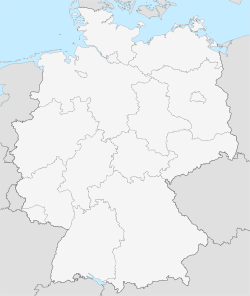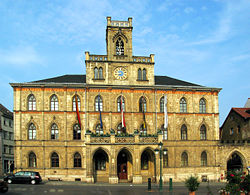Weimar
| Weimar | |
| Coat of arms | Location |
 |
 |
| Administration | |
| Country | Germany |
|---|---|
| State | Thuringia |
| District | Urban district |
| Town subdivisions | 21 districts |
| Lord Mayor | Stefan Wolf (SPD) |
| Basic statistics | |
| Area | 84.26 km² (32.5 sq mi) |
| Elevation | 208 m (682 ft) |
| Population | 64,481 (30/12/2006)[1] |
| - Density | 765 /km² (1,982 /sq mi) |
| Other information | |
| Time zone | CET/CEST (UTC+1/+2) |
| Licence plate | WE |
| Postal codes | 99401–99441 |
| Area codes | 03643, 036453 |
| Website | www.weimar.de |
| Classical Weimar* | |
|---|---|
| UNESCO World Heritage Site | |
 |
|
| State Party | |
| Type | Cultural |
| Criteria | iii, vi |
| Reference | 846 |
| Region** | Europe and North America |
| Inscription history | |
| Inscription | 1998 (22nd Session) |
| * Name as inscribed on World Heritage List. ** Region as classified by UNESCO. |
|
Weimar (IPA: [ˈvaɪmaʁ]) is a city in Germany. It is located in the Bundesland of Thuringia (German: Thüringen), north of the Thüringer Wald, east of Erfurt, and southwest of Halle and Leipzig. Its current population is approximately 64,000. The oldest record of the city dates from the year 899. Weimar was the capital of the Duchy (after 1815 the Grand Duchy) of Saxe-Weimar (German Sachsen-Weimar). In the 20th century, the city gave its name to the Weimar Republic.
Contents |
History


18th and 19th centuries
Weimar is one of the great cultural sites of Europe, Having been home to such luminaries as Bach, Goethe, Schiller, and Herder; and in music the piano virtuosi Hummel (a pupil of Mozart) and Liszt. It has been a site of pilgrimage for the German intelligentsia since Goethe first moved to Weimar in the late 18th century. The tombs of Goethe and Schiller as well as their archives, may be found in the city. Goethe's Elective Affinities (1809) is set around the city of Weimar.
Weimar Republic
The period in German history from 1919 to 1933 is commonly referred to as the Weimar Republic, as the Republic's constitution was drafted here because the capital, Berlin, with its street rioting after the 1918 German Revolution, was considered too dangerous for the National Assembly to use it as a meeting place. Weimar was, beside Dessau, the center of the Bauhaus movement. The city houses art galleries, museums and the German national theatre. The Bauhaus University and the Liszt School of Music Weimar attracted many students, specializing in media and design, architecture, civil engineering and music, to Weimar.
World War II
During World War II, there was a concentration camp near Weimar, at Buchenwald, only 8 kilometers from the city center. More than 55,000 prisoners entered the gates bearing the motto "Jedem das Seine" ("to each his due") The Buchenwald concentration camp provided slave labour for local industry.[2]
German Democratic Republic
Weimar was part of the German Democratic Republic from 1949 to 1990.
Recent years
The European Council of Ministers selected the city as a European Capital of Culture for 1999.
On September 3, 2004, a fire broke out at the Duchess Anna Amalia Library. The library contains a 13,000-volume collection including Goethe's masterpiece Faust, in addition to a music collection of the Duchess. An authentic Lutheran Bible from 1534 was saved from the fire. The damage stretched into the millions of dollars. The number of books in this historic library exceeded 1,000,000, of which 40,000 to 50,000 were destroyed past recovery. The library, which dates back to 1691, belongs to UNESCO world heritage, and is one of the oldest public libraries in Europe. The fire, with its destruction of much historical literature, amounts to a huge cultural loss for Germany, Europe, and indeed the world. A number of books were shock-frozen in the city of Leipzig to save them from rotting.
Famous residents of Weimar




- Johann Sebastian Bach
- Uziel Gal
- Hector Berlioz
- Hans von Bülow
- Peter Cornelius
- Lucas Cranach the Elder
- Marlene Dietrich
- Lyonel Feininger
- Johann Wolfgang von Goethe
- Walter Gropius
- Nina Hagen
- Johann Gottfried Herder
- Johann Gottfried Walther
- John Horrocks
- Johann Nepomuk Hummel
- Johannes Itten
- Joseph Joachim
- Wassily Kandinsky
- Harry Graf Kessler
- Paul Klee
- Franz Liszt
- Martin Luther
- László Moholy-Nagy
- Friedrich Nietzsche
- Friedrich Preller
- Joseph Joachim Raff
- Friedrich Schiller
- Oskar Schlemmer
- Arthur Schopenhauer
- Frédéric Soret
- Rudolf Steiner
- Richard Strauss
- Henry van de Velde
- Richard Wagner
- Christoph Martin Wieland
- Carl Zeiss
Districts
- Ehringsdorf
- Gaberndorf
- Gelmeroda
- Holzdorf
- Legefeld
- Niedergrunstedt
- Oberweimar
- Possendorf
- Schöndorf
- Süßenborn
- Taubach
- Tiefurt
- Tröbsdorf
Education
- Bauhaus-University Weimar
- Liszt School of Music Weimar [1]

Transportation
It is connected by one motorway and two routes:
- Autobahn
- A4
- Routes:
- 7
- 85
Sister cities
External links
- Weimar's official website
- Historic tour in 49 pictures
- Ginkgo Museum, Weimar
- Deutsches Nationaltheater
References
- ↑ Thüringer Landesamt für Statistik. "Population data". Retrieved on 2007-08-10.
- ↑ Edward Victor.Alphabetical List of Camps, Subcamps and Other Camps.www.edwardvictor.com/Holocaust/List %20 of %20 camps.htm
|
||||||||
|
|||||
|
|||||||